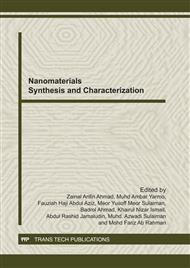p.196
p.202
p.206
p.211
p.217
p.222
p.228
p.232
p.238
V2O5-Polyaniline Nanocomposite as a Catalyst for Heterogeneous Ozonolysis of Oleic Acid
Abstract:
Nanocomposite V2O5-polyaniline (pani) is produced via micelle solution by using cationic surfactant (cetyltrimethyl ammonium bromide, CTAB) and vanadyl sulfate hydrate as a precursor. TEM results showed that V2O5-pani nanocomposite with 20-70 nm in size is formed via micelle solution. This nanocomposite as catalyst is utilized the production of azelaic acid (AA) and pelargonic acid (PA) from oleic acid cleavage in solvent free medium. Various loading percentages of V2O5 in Pani are considered and their differences in activity and selectivity are also evaluated. According to GC analysis, results showed that nanocomposite as catalyst is two times more selective to AA compare to bulk V2O5 (53%, 28% respectively). Also this nanocomposite indicated higher selectivity to AA and PA rather than nanoV2O5 (53% compare to 32%) It is showed that in higher weight percentage of V2O5 to polyaniline, the conversion of OA to two main products, AA and PA in ozonolysis reaction ( according to Criegee mechanism ) is higher. Ozone absorption of OA is monitored by FT-IR and the activity and selectivity of catalyst is monitored by GC-FID.
Info:
Periodical:
Pages:
217-221
Citation:
Online since:
October 2011
Keywords:
Price:
Сopyright:
© 2012 Trans Tech Publications Ltd. All Rights Reserved
Share:
Citation:


